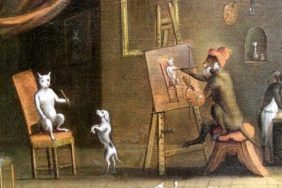Artwork: Tabakskollegium [Tobacco Club], Abraham Teniers, mid-17th century. Courtesy of the Public Domain Review
The public domain is home to works whose exclusive intellectual property rights have expired—meaning that anyone can use the work for personal or professional use. The public domain includes just about anything you can imagine from books, films, and audio recordings to the formulae of Newtonian physics, cooking recipes, and all software before 1974.
Also: The World Famous “Afghan Girl” Makes Headlines as Refugee Arrested in Pakistan
Three sites offer the public entrée into this magical world: The Public Domain Project, The Public Domain Review, and Project Gutenberg, each providing tens of thousands of classic and obscure works.

Apollo 11 mission to the moon. Courtesy of the Public Domain Review
The phrase “public domain” arose in the mid-eighteenth century, after the first early copyright law was established in Britain in 1710, to cover works not covered under these laws. The French poet Alfred de Vigny was the first to address the expiration of copyright, observing works would then fall “into the sinkhole of the public domain,” clearly indicating his distaste for the inevitable passage of time that makes all but the most protected works open to free use.
When a work falls into the public domain, such as it were, anyone in the public can use its contents for creative or professional use. Consider the classics of literature, from Shakespeare, Mark Twain, and Edgar Allen Poe to H.G. Wells, Jane Austen, and Lewis Carroll: select works are available to anyone wishes to keep them in print, reminding us that the best way to keep art alive is to make it widely available.

The Cheetah (1886) from The Bestiarium of Aloys Zötl (1831-1887). Courtesy of the Public Domain Review
The Public Domain Project makes more than 9,000 pieces of footage, 473 audio files, 64,500 images, and 120 3D models available for use, although they do charge a membership fee. Whereas the Public Domain Review is a non-profit that is free, and Project Gutenberg offers 53,000 free e-books exclusively in the United States.
Among the most popular works at Project Gutenberg are The Kama Sutra of Vatsyayana, Bram Stoker’s Dracula, Plato’s Republic, and Henry David Thoreau’s Walden—basically any classic you’ve ever been required to read in high school or college can be found for free. There are also handy volumes like William Strunk’s The Elements of Style and the United States Office of Strategic Services’s Simple Sabotage Field Manual as well as classic sci-fi novels by Philip K. Dick.

Benjamin Lyman Morrison of Ripley, Massachusetts, born in 1828. Courtesy of the Public Domain Review
The Public Domain Review provides images, books, film, audio recordings, and animated gifs spanning the sixteenth through twentieth centuries. The site is beautifully curated to make browsing a joy, whether you’re looking photographs from the collection of a nineteenth century sexologist, portraits of wounded soldiers from the Civil War, a selection of classic beards that put hipsters to shame, phrenology diagrams and hypnotism posters, scenes from the opium destruction in San Francisco in 1914, or high-resolution images and audio recordings from the Apollo missions
The Public Domain Project features digital models of NASA tools and satellites, speeches by political luminaries from Dr. Martin Luther King Jr. to Winston Churchill, recordings of performances from composers like Beethoven, as well as a photo of President Barack Obama playing pool.

American magician Harry Kellar’s show posters. Courtesy of the Public Domain Review
Taken as a whole, the Public Domain is a wondrous world of yesterday’s highlight reels. It’s a curious mixture of the brilliant and the bogus, the insightful and the absurd, offering a look at the spectacle of the human mind across cultures and throughout time as it seeks to find new solutions to old problems or simply to amuse and delight. But what’s most astounding is that it is all available to the public to use as they would like.
Miss Rosen is a New York-based writer, curator, and brand strategist. There is nothing she adores so much as photography and books. A small part of her wishes she had a proper library, like in the game of Clue. Then she could blaze and write soliloquies to her in and out of print loves.






